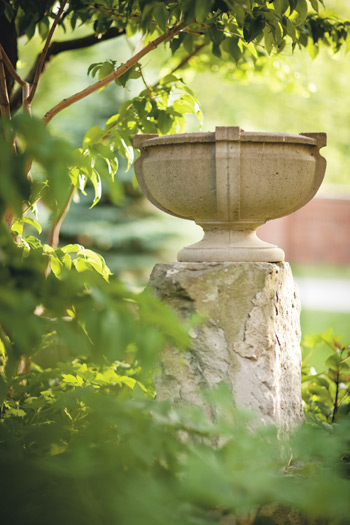Written by Kelly Roberson
Photos by Kathryn Gamble

For some of us, an empty lot is just, well, an empty lot.
And then there are those homeowners who see things differently. A falling-down staircase becomes a focal point with a little love and new banisters. Some sanding, new stain and a refurbished foundation give a crumbling porch new life as a spot for entertaining. And an empty lot offers the promise of an urban oasis.
That, at least, was how Wade Scherrer saw things when the city condemned and then tore down the abandoned, burned-out structure adjacent to his Sherman Hill home. Today, the once-forsaken space is one of the prettiest year-round landscapes in the city, a respite for Scherrer amid the din of nearby busy streets.
Possibilities Unleashed
After the house next door was removed, two trees, a catalpa and an oak, were all that remained. Scherrer and his then-partner bought the long, narrow lot, mowed it and put in a few inexpensive plants, and then Scherrer began thinking both small- and big-picture. He knew, for example, that he wanted some privacy from the street and to create picturesque views he could see from inside his house.
But mostly, Scherrer wanted a fountain. “I wanted one large enough to produce a sound that would mask street noise,” he says.
So the five-tiered fountain more or less came first. When he bought the structure at Created in Johnston, he found out that he would need a pool at least 12 feet in diameter to accommodate it. So in went a pool, in a do-it-yourself feat that Scherrer describes as “just jumping in and doing it. We’d never done any of this before.”
Plants and Privacy
The fountain and pool, as well as an airy metal gazebo that was installed at about the same time, became the garden’s superstars. Although all of them were purchased new, they now have an aged, weather-beaten look.
As much as the space developed organically—and looks completely natural—there were organizing principles to the design, which makes sense given that Scherrer spends his days as a producer for magazines at Meredith Corp. For example, he decided to loosely divide the lot by threes. That offered him a way to conquer practical problems, such as the slope of the lot from the front walk to the back alley. “Because it’s long and narrow, I wanted to find a way to break it up,” Scherrer says. “By dividing it, it starts to feel like smaller individual rooms instead of one long lot.”
Next came Scherrer’s deft play with privacy. The front third of the lot is firmly partitioned from the street with a hedge and tall evergreens. “I spend a lot of time on the back porch, so I wanted plantings that would block the views of the street and neighborhood,” he says. “And I wanted evergreens for interest all year round.”
The middle third steps down a bit from the upper level; access is under brick and stone arches that mimic the materials used on the house. The feel of that section is at once both intimate and open, making the space equally at home hosting groups gathered on a summer evening or just Scherrer. Stepped down a bit more is the last third, open to the alley and with a small, manicured lawn.
The types of plants used were an intentional decision by Scherrer. “I wanted formal and woodland elements in a garden that would evolve naturally over time,” he says.
The color palette was deliberate, too. It’s all whites, blues, and purples—cool-colored flowers—and a tapestry of all kinds of greens, from chartreuse to minty. “For me, it was important to have a garden that would be a cool, calm respite, whether in the garden or looking out on it,” Scherrer says.
Architectural Elements
Many gardens go all out with plants, but fall flat once the blooms have faded. Scherrer’s space works much harder year-round to maintain both its hard-won privacy and its beauty. Throughout the garden are small focal points made up of plants as well as architectural elements. “I tried to make vignettes that you discover while walking around,” Scherrer says. “I wanted there to be a sense of exploration, wonder, and surprise.”
Even from inside the house, the vantage points change. The fountain lines up with the first floor bay window and Scherrer’s bedroom window. Boxwoods and yews—green all year round—can be shaped as Scherrer sees fit, as can other sculptural trees, such as a contoured filbert, its under-canopy trimmed for a bit of living sculpture.
There are the big pieces, of course—that fountain and gazebo—but what’s even more delightful are unexpected discoveries. Here and there are bits of a column, a cornice, an unusual bell, birdbaths and urns. Their provenance has never been important to Scherrer; they are a mix of big-box purchases, vintage finds and castoffs. For example, when the Iowa State Capitol was under renovation, “you could take a vehicle down there and they would give you pieces,” Scherrer says. “It was a way to get a piece of history that automatically gave the garden substance and narrative.”
The result, of course, is a garden that, though fairly young, feels perfectly in time with the historic fabric of the neighborhood. And Scherrer continues to trim and cultivate, enjoying the sanctuary he created. “This garden is a living thing,” he says. “Like a child, it’s amazing to see how it changes from year to year.”
A five-tiered fountain and pool, plus an airy metal gazebo, are the garden’s superstars. The sound of the fountain helps to mask noise from the nearby street.
Architectural elements and other items, such as an urn, a cherub and part of a fence, form small focal points throughout the garden.




















